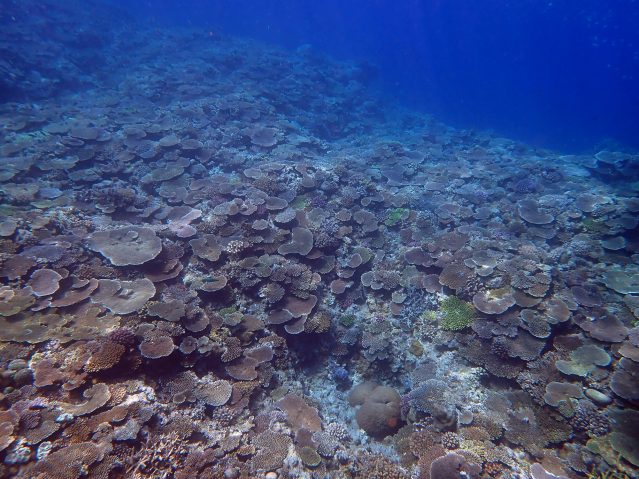Okinawa Institute of Science and Technology (OIST) scientists have devised a method for measuring coral biodiversity by extracting environmental DNA (eDNA) from a liter of surface seawater sampled above a reef.
 Coral reefs are home to around 30% of marine life but researchers say that recent global warming and other factors have caused bleaching, and many coral reefs are in danger of disappearing. The new eDNA method is set to make monitoring the coral reefs faster, easier, and cheaper. The coral reef pictured is just one of the reefs that researchers looked at around Okinawa. Image Credit: Okinawa Institute of Science and Technology.
Coral reefs are home to around 30% of marine life but researchers say that recent global warming and other factors have caused bleaching, and many coral reefs are in danger of disappearing. The new eDNA method is set to make monitoring the coral reefs faster, easier, and cheaper. The coral reef pictured is just one of the reefs that researchers looked at around Okinawa. Image Credit: Okinawa Institute of Science and Technology.
Investigations performed by scientific divers in the same parts of the ocean have confirmed that the procedure works. The research was carried out in partnership with the Okinawa Prefecture Environmental Science Center and the University of Tokyo. The study was published in the Proceedings of the Royal Society B: Biological Sciences.
This has cleared the path for large-scale comprehensive surveys of reef-building coral to take place and reduces the dependency on direct observations collected through scientific scuba diving or snorkeling.
Beautiful coral reefs in subtropical and tropical seas account for only 0.2% of the entire ocean. However, they are the most biodiverse areas of the oceans, home to about 30% of all marine life. Reef-building corals play a key role in creating coral reefs, but recent global warming and other factors have caused bleaching, and many coral reefs are in danger of disappearing.
Nori Satoh, Study Co-Author, Professor and Principal Investigator, Marine Genomics Unit, Okinawa Institute of Science and Technology
To conserve and safeguard coral reefs, it is necessary to first understand which corals are on the reef and how the reef’s makeup changes over time. Earlier, the only efficient approach to surveying a reef was for divers and snorkelers to observe the coral directly and document the species and changes over time. This was time-consuming, costly, and labor-intensive.
However, researchers are increasingly utilizing the DNA that living organisms leak into the environment via the skin, waste products, and mucus. By collecting and analyzing this eDNA from saltwater, a clear image of the creatures that occupy that region of the ocean can be discovered without ever having to enter the water.
Reef-building coral, often known as hard coral, is an essential component of coral reefs. There are around 1,300 species of reef-building corals in 236 genera globally, according to estimates. These corals expel mucus into the surrounding ocean, which contains fragments of DNA. OIST and University of Tokyo scientists excelled in 2021 in developing methods that replicate and detect the DNA of 45 genera of reef-building coral.
The scientists have now conducted a large-scale study of the ocean surrounding Okinawa using both the eDNA approach and scientific divers to see if these tools are successful and accurate. Two divers used direct visual observation to identify dominant coral genera, and two or three 1 l bottles of surface seawater were collected at each site.
Seawater was filtered as soon as possible to fix any environmental DNA that had been caught in the filters, and the filters were returned to the OIST laboratory for analysis. From early September to late December 2021, 62 sites on Okinawa’s main island were inspected, and two to four dominant coral genera at each reef were documented.
We found that the eDNA analysis matched that of the direct scientific observations with more than 91% accuracy. In fact, 41 out of the 62 sites were identical. The eDNA method indicated the presence of five dominant coral genera at all 62 sites surveyed. What’s more the results of the environmental DNA method suggest the presence of corals never before recorded along the coast of Okinawa.
Dr. Koki Nishitsuji, Study First Author and Research Scientist, Okinawa Institute of Science and Technology
Since the eDNA approach necessitates complicated sequencing information, only 45 of the anticipated 236 genera could be identified. The efficiency of the eDNA approach will improve as more information becomes available. Furthermore, while more research needs to be done, the eDNA approach may be able to detect the existence of corals that are difficult to detect from direct observation.
Journal Reference:
Nishitsuji, K., et al. (2023). An environmental DNA metabarcoding survey reveals generic-level occurrence of scleractinian corals at reef slopes of Okinawa Island. Proceedings of the Royal Society B: Biological Sciences. doi.org/10.1098/rspb.2023.0026.